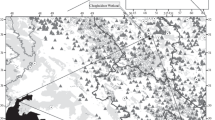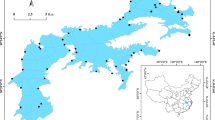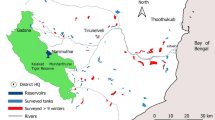Abstract
Monthly surveys were conducted on Kennedy Space Center for one year to determine densities of waterbirds within impounded salt marshes that were predominantly open water with little emergent vegetation. The objective was to assess the importance of these impoundments to waterbirds, particularly wading birds, which are species of special conservation concern. Water-level management for mosquito control and waterfowl provided habitat for an abundance of ducks, shorebirds, coots, and wading birds. Average densities throughout the year for these groups were 5.26, 4.12, 2.80, and 2.20 birds/ha, respectively. The majority of waterfowl were present during the winter. Shorebirds were most common during spring migration. Wading bird densities increased with declining water level. Due to the extensive alteration and development of coastal wetlands in central Florida, properly managed impoundments may provide important feeding areas for maintaining certain waterbird populations.
Similar content being viewed by others
Literature Cited
Bellrose, F.C. 1976. Ducks, geesc, and swans of North America. Stackpole Books, Harrisburg, PA, USA.
Bent, A.C. 1926. Life Histories of North American Marsh Birds. Dover Publishing, Inc. New York, NY, USA.
Bidlingmayer, W.L. 1982. Surveying salt marsh mosquito control impoundments in central Florida. Journal of the Florida Anti-Mosquito Association 53: 4–7.
Brush, T., R.A. Lent, T. Hruby, B.A. Harrington, R.M. Marshall, and W.G. Montgomery. 1986. Habitat use by salt marsh birds and response to open water marsh management. Colonial Waterbirds 9:189–195.
Burger, J. 1984. Abiotic factors affecting migrant shorebirds. p. 1–72.In J. Burger and B.L. Olla (eds.) Behavior of Marine Animals Vol. 6 Shorebirds: Migration and Foraging Behavior. Plenum Press, New York, NY, USA.
Burger, J., J.K. Shisler, and F.H. Lesser. 1982. Avian utilization on six salt marshes in New Jersey. Biological Conservation 23:187–212.
Chabreck, R.N. 1980. Effects of marsh impoundment on coastal fish and wildlife resources. p. 1–16.In P.L. Fore and R.D. Peterson (eds.) Proceedings of the Gulf of Mexico Coastal Ecosystems Workshop. U.S. Fish and Wildlife Service, Albuquerque, NM, USA. FWS/OBS-80/30.
Chabreck, R.N., R.K. Yancey, and L. McNease. 1975. Duck usage of management units in the Louisiana coastal marsh. Proceedings of the Annual Conference of the Southeastem Association of the Game and Fish Commission 28:507–516.
Chamberlain, Jr., E.B. 1960. Florida waterfowl populations, habitats, and management. Technical Bulletin No. 7. Florida Game and Fresh Water Fish Commission.
DeGange, A.K. 1978. American avocet. p. 88–89.In H.W. Kale II (ed.) Rare and Endangered Biota of Florida, Vol. 2: Birds. University Presses of Florida, Gainesville, FL, USA.
Epstein, M.B. and R.L. Joyner. 1986. Use of managed and opentidal marsh by waterbirds and alligators. p. 529–579.In M.R. Devoe and D.S. Baughman (eds.) South Carolina coastal wetland impoundments: Ecological characterization, management, status, and use. Vol. 2: Technical synthesis. Publication No. SC-SG-TR-82-2. South Carolina Sea Grant Consortium, Charleston, SC, USA.
Epstein, M.B. and R.L. Joyner. 1988. Proceedings of the Annual Conference of the Southeastem Association of Fish and Wildlife Agencies 42:476–490.
Erwin, R.M. 1986. Waterfowl and wetlands management in the coastal zone of the Atlantic flyway: Meeting summary and comments. Colonial Waterbirds 9:243–245.
Fasola, M. 1986. Resource use of foraging herons in agricultural and nonagricultural habitats in Italy. Colonial Waterbirds 9:139–148.
Gilmore, R.G. 1987. Fish, macrocrustacean, and avian population dynamics and cohabitation in tidally influenced impounded subtropical wetlands. p. 373–394.In W.R. Whitman and W.H. Meredith (eds.) Proceedings of a Symposium on Waterfowl and Wetlands Management in the Coastal Zone of the Atlantic Flyway. Delaware Department of Natural Resources and Environmental Control, Wilmington, DE, USA.
Gilmore, R.G., D.W. Cooke, and C.J. Donohoe. 1982. A comparison of the fish populations and habitat in open and closed salt marsh impoundments in east-central Florida. Northeastern Gulf Science 5:25–37.
Gilmore, R.G., P.B. Hood, R.E. Brockmeyer, Jr., and D.M. Scheidt. 1985. Salt marsh fishery managemetn and restoration technique analysis. Final Report. Harbor Branch Oceanographic Institution, Ft. Pierce, FL, USA.
Girard, G.T. and W.K. Taylor. 1979. Reproductive parameters for nine avian species at Moore Creek, Merritt Island National Wildlife Refuge, Florida. Florida Scientist 42:94–120.
Jenni, D.A. 1969. A study of the ecology of four species of herons during the breeding season at Lake Alice, Alachua County, Florida. Ecological Monographs 39:245–270.
Joanen, T. and L.L. Glasgow. 1965. Factors influencing the establishment of wigcongrass stands in Louisiana. Proceedings of the Annual Conference of the Southeastern Association of the Game and Fish Commission. 19:78–92.
Johnson, J.A., F. Montalbano III, and T.C. Hines. 1984. Population dynamics and status of the mottled duck in Florida. Journal of Wildlife Management 48:1137–1143.
Kushlan, J.A. 1978. Feeding ecology of wading birds. p. 249–298.In A. Sprunt IV., J.C. Ogden, and S. Winckler (eds.) Wading Birds. National Audubon Society, New York, NY, USA.
Kushlan, J.A., O.L. Bass, Jr., and L.C. McEwan. 1982. Wintering waterfowl in Everglades National Park. National Park Service Report T-670, Homestead, FL, USA.
Leenhouts, W.P. 1983. Marsh and Water Management Plan, Merritt Island National Wildlife Refuge. Titusville, FL, USA.
Leenhouts, W.P. and J.L. Baker. 1982. Vegetation dynamics in dusky seaside sparrow habitat on Merritt Island National Wildlife Refuge. Wildlife Society Bulletin 10:127–132.
Lowe, E.F., J.E. Brooks, C.J. Fall, L.R. Gerry, and G.B. Hall. 1984. U.S. EPA clean lakes program, phase 1: Diagnostic feasibility study of the upper St. Johns River chain of lakes, Vol. 1: Diagnostic study. Technical Publication S.T84-15. Department of Water Resources, St. Johns Water Management District, Palatka, FL, USA.
Montague, C.L., A.V. Zale, and H.F. Percival. 1986. Final report. A conceptual model of salt marsh management on Merrit Island National Wildlife Refuge, Florida. Florida Cooperative Fish and Wildlife Research Unit. Technical Report No. 17, Gainesville, FL, USA.
Montague, C.L., A.V. Zale, and H.F. Percival. 1986. The nature of export from fringing marshes, with reference to the production of estuarine animals and the effect of impoundments. p. 437–450.In W.R. Whitman and W.H. Meredity (eds.) Proceedings of the Waterfowl and Wetlands Symposium. Delaware Coastal Management Program, Delaware Department of Natural Resources and Environmental Control, Dover, DE, USA.
Montalbano III, F. 1980. Summer use of two central Florida phosphate settling ponds by Florida ducks. Proceedings of the Annual Conference of the Southeastern Association of Fish and Wildlife Agencies 34:584–590.
Morales, G. and J. Pacheco. 1986. Effects of diking of a Venezuelan savanna on avian habitat, species diversity, energy flow, and mineral flow through wading birds. Colonial Waterbirds 9:236–242.
Morgan, P.H., A.S. Johnson, W.P. Baldwin, and J.L. Landers. 1976. Characteristics and managemen of tidal impoundments for wildlife in a South Carolina estuary. Proceedings of the Southeastern Association of the Game and Fish Commission 29:526–539.
NASA. 1979. Environmental impact statement for the Kennedy Space Center. Washington, DC, USA.
Nesbitt, S.A., J.C. Ogden, H.W. Kale II, B.W. Patty, and L.A. Rowse. 1982. Florida atlas of breeding sites for herons and their allies: 1976-78. U.S. Fish and Wildlife Service Office of Biological Services, Washington, DC, USA. FWS/OBS-81/49.
Ogden, J.C., J.A. Kushlan, and J.T. Tilmant. 1976. Prey selectivity by the wood stork. Condor 78:324–330.
Osborn, R.G. and T.W. Custer. 1978. Herons and their allies: Atlas of Atlantic Coast colonies, 1975 and 1976. U.S. Fish and Wildlife Service Biological Services Program, Washington, DC, USA. FWS/OBS-77/08.
Paul, R.T., H.W. Kale II, and D.A. Nelson. 1979. Reddish Egrets nesting on Florida’s east coast. Florida Field Naturalist 7:24–25.
Provost, M.W. 1967. Managing impounded salt marsh for mosquito control and estuarine resource conservation. p. 163–171.In J.D. Newson (ed.) Proceedings of the Louisiana State University Marsh and Estuary Management Symposium. Louisiana State University, Division of Continuing Education, Baton Rouge, LA, USA.
Provost, M.W. 1969. Ecological control of salt marsh mosquitos with side benefits to birds. Proceedings of the Tall Timbers Conference of Ecological Animal Control by Habitat Management 1:193–206.
Rey, J.R., J. Shaffer, D. Tremain, R.A. Crossman, and T. Kain. 1990. Effects of re-establishing tidal connections in two impounded subtropical marshes on fishes and physical conditions. Wetlands 10:27–45.
Rundle, W.D. and L.H. Fredrickson. 1981. Managing seasonally flooded impoundments for migrant rails and shorebirds. Wildlife Society Bulletin 9:80–87.
Smith, R.B. and D.R. Breininger. 1988. Northern breeding range extension for the Roseate Spoonbill in Florida. Florida Field Naturalist 16:65–67.
Snclson, Jr., F.F. 1976. A study of a diverse coastal ecosystem on the Atlantic coast of Florida: Inchthyological studies, Vol. 1. Final Grant Report, Grant NGR-10-019-004. NASA, Kennedy Space Center, FL, USA.
Trost, C. H. 1968. Study of wildlife usage of salt marsh on east coast of Florida before and after impoundment for mosquito and sandfly control. Final Report Bureau of Sport Fisheries and Wildlife, U.S. Fish and Wildlife Service Contract No. 14-16-0008-623.
Wood, D.A. (comp.). 1987. Official lists of endangered and potentially endangered fauna and flora. Florida Game and Fresh Water Fish Commission, Tallahassee, FL, USA.
Author information
Authors and Affiliations
Rights and permissions
About this article
Cite this article
Breininger, D.R., Smith, R.B. Waterbird use of coastal impoundments and management implications in east-central Florida. Wetlands 10, 223–241 (1990). https://doi.org/10.1007/BF03160834
Received:
Revised:
Accepted:
Issue Date:
DOI: https://doi.org/10.1007/BF03160834




